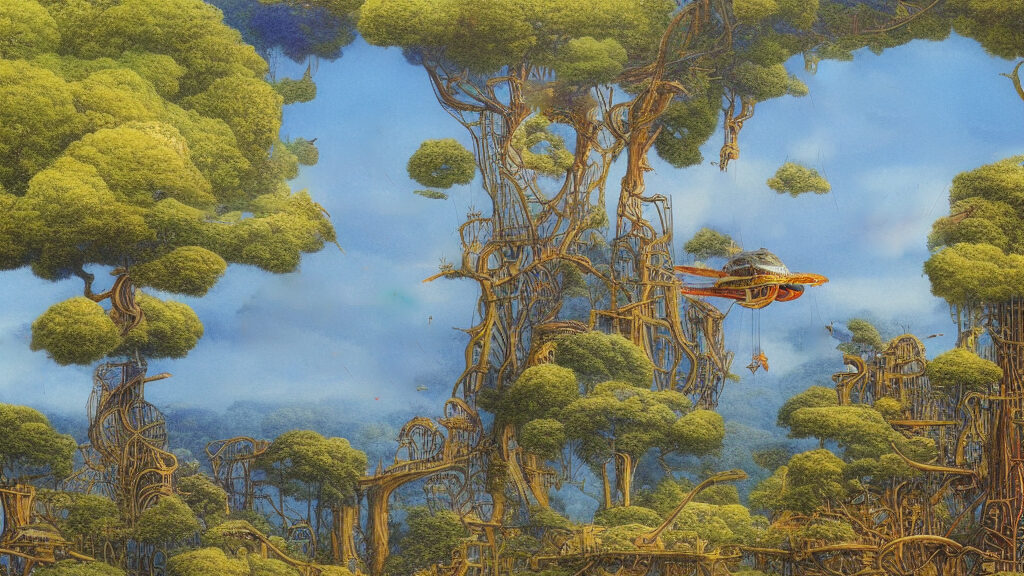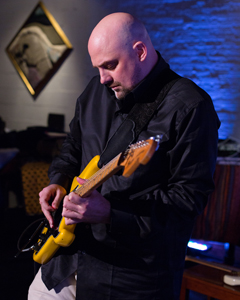
How did you come up with the concept of combining rock with chamber music and vocal polyphony?
I’m not sure that I came up with it so much as it just presented itself to me. I’ve been fairly immersed in classical music for the past 20 years or so, but I had an experience in the spring of 2010 that made me want to revisit my roots in rock music, especially with regards to rhythm as realized by drums and electric bass. At the same time, there are so many things I’ve absorbed from classical music — especially when it comes to elements of harmony, form, and instrumental texture — that I couldn’t imagine not wanting to continue to explore.
The idea of using polyphonic vocals came from wanting to avoid the usual “lead singer” scenario, where one person kind of assumes vocal duties and becomes the focal point of the band. Don’t get me wrong — it’s a classic and viable format, but I wanted to do something different. I love the sound of certain Renaissance composers’ music, like Carlo Gesualdo and Palestrina, among others: there is a very fluid quality to the writing that I’ve always been attracted to. I was also interested in echoing some of the popular music from the 60s, when vocal groups like The Supremes, The Four Tops, The Beach Boys, etc. were generally much more prevalent than they are now. In some way, I guess I was trying to draw a connection among those various styles and approaches to music, all of which have had a profound impact on me.
Tell us about the concept of the album.
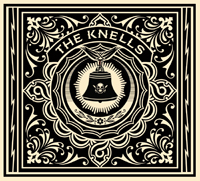
A knell is a funereal bell. Why the name Knells?
We took the name of the band from a track on the album called Spiral Knells, which is essentially a song about confusion, relativity, and one’s perception of existence. In my head, I connected these ideas with the Hindu/Buddhist concept of samsara, which can loosely be described as the eternal cycle of life, suffering, and death, and in which I have always had a philosophical interest. I chose the word “knell” for inclusion in the title because of its associations with death, and also because the last minute or so of the song features these huge, bell-like guitar chords that just ring out into nothing…
On a much less philosophical and more practical level, I also just like the sound of the word, and appreciate its sonic implications. In light of all these considerations, and the fact that it’s simple and memorable, we all agreed that “The Knells” would make a good name for the band.
The musicians involved in The Knells come from diverse musical backgrounds. How did you connect with them?
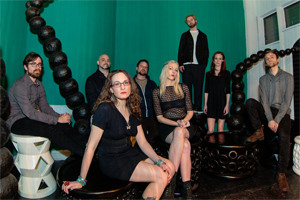
I met Nina Berman and Amanda Gregory through a composer friend of mine who had worked with them in an opera he wrote, and they introduced me to Katya Powder.
Most everybody in the band has studied classical music fairly extensively: it’s a relatively small world, so connecting with people is usually just a process of asking around, meeting people, and seeing what works out. Paul is perhaps the small exception, as he comes from more of a jazz and fusion background, but he too has had some formal training in music.
You’ve been performing in the New York area. How are audiences reacting and what types of audiences are you getting?
So far, it’s mostly just been friends and members of our community, which can probably best be described as the “New York, new music” scene. One of our first shows was for a group of interpretive dancers, which was quite unusual! So far, the reaction has been positive and supportive, which is encouraging.
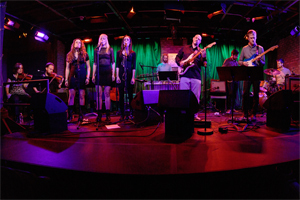
There are some interesting, “prog-related” things happening here, though. Toby Driver and Kayo Dot are based here, and there are a lot of more “classical” composers who are incorporating elements of rock into classical compositions and new ensembles. My friend David T. Little and Newspeak come to mind, and Bryce Dessner, one of the guitarists in The National, has been building a career as a “modern classical” composer. All in all, it seems like a fertile time to be exploring the boundaries of different styles of music.
Are there plans to take the group on tour outside of the New York region? Will it include MIVOS String Quartet?
We would of course love to play as much, and in as many different places, as possible. Touring presents some logistical challenges: with 4 people it’s difficult, with 8 it’s impractical, and with 12 it’s pretty much impossible, unless you have some serious outside and/or institutional support. There are also technical challenges: not to be precious about it, but a lot of the Knells vocal harmonies are quite delicate; consequently, we need a good PA and a decent monitor setup to feel comfortable, not to mention a stage large enough to accommodate all of us.
At present, the goal is to try and figure out how to tour with the 8-piece ensemble, but allow room for smaller, more stripped down shows as well. Fortunately, the Knells music is “convertible” in the sense that it can work in different arrangements: all the tunes we play work without strings, and most of them work for simply the three singers and guitar accompaniment. Naturally, the music takes on a different vibe in this context, but I think that’s one of the defining qualities of good songwriting — a tune should be able to work in different arrangements.
Figuring out how to simply manage this is probably going to keep me preoccupied for the foreseeable future, but I’m definitely looking towards the future with any eye for developing it into something bigger, and finding a way to implement additional instrumental forces when possible.
What is your musical background?

For me, playing the guitar has always been at the service of writing. I’ve always been attracted to more free flowing, through-composed musical forms versus the more boxy forms used in conventional songwriting, and all through my teens I felt very hemmed in by most of the musical forms I was hearing in a lot of the rock and pop music I was listening to. Obviously, it was this dissatisfaction that led me to bands like Yes, King Crimson, Rush, and even Michael Hedges. My decision to study composition (rather than guitar) in college was firmly rooted in my desire to figure out how to create those larger forms in my own music, which I struggled a lot with when I was in my teens.
This ultimately led me to more academic pursuits. I’ve been very fortunate to have the opportunities I’ve had to study and develop my craft, and I wouldn’t trade any of the experiences I’ve had studying music for anything. I’ve had incredible teachers and mentors who encouraged me in different, profoundly meaningful ways, and have been exposed to so many things that I likely never would have been otherwise. This isn’t to say that I don’t have serious issues with academia, because I do, but overall it has been an extremely valuable path for me, artistically speaking.
Your guitar style is very eclectic. What guitarists have inspired you?
In the order that I “discovered” them: Jimmy Page, Alex Lifeson, Michael Hedges, and Steve Tibbets. Page and Lifeson taught me about the electric guitar and rock music. Hedges’ music vastly expanded my ideas about what the guitar is capable of, technically, texturally, and harmonically speaking. Steve Tibbets taught me how to combine and synthesize various approaches and aesthetics… At this point, I’d say that Tibbets is probably my biggest influence: in many ways, I feel like I’m trying to accomplish what he has, but I’m drawing from a slightly different set of stylistic influences. His playing also just has this really beautiful, aggressive quality to it that I can’t get enough of, even in his more subdued work.
What guitar models do you play? Do you still play your earlier guitars?
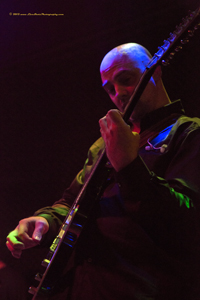
Andrew McKenna Lee – Photo credit: Live Shots Photography
At heart, I’m really a Stratocaster guy — I like their weight, feel, and the way the electronics are configured. I especially appreciate being able to wrap my pinky around the volume knob, as I enjoy doing volume and wah swells together. I also like EMGs: they’re super quiet, which is great for dynamics, and I prefer their somewhat more neutral tone to the more immediately identifiable single coil sound of a regular Strat. As for amps, I’m generally happy with Fender Twins, Super Reverbs, Deluxes, etc., but I’ve played through many others that I also like.
Generally speaking, I’m not all that particular about electric guitars and amps. On the other hand, I tend to be pretty fussy about classical guitars.
And what effects do you use?
I have an MI Audio Tube Zone overdrive and an EMMA Electronics Reezafratzitz distortion pedal for more high gain stuff, both of which I love. I also use a Bud Wah, an MXR Phase 90 with the clipped R28 resistor mod (which seems to smooth out a low-mid bump in the newer model that I don’t like too much), a Mooer Trelicopter (for tremolo), a Boss DD6 digital delay, and an EHX Holy Grail Nano. The Boss DD6 is great, but I think I’m going to replace it with an analog delay at some point. I also have an MXR Compressor on board right now, but I don’t use it too much: I might substitute something more interesting for it in the future — like a POG! On the record, I used a Moog MuRF. It’s awesome, but it’s too big to lug around on a pedal board. I approximate it live by using the Phase 90 with the Trelicopter. Generally speaking, Paul, our other guitar player, has some more interesting and esoteric effects that I’m jealous of.
Do you intend to release additional recordings with The Knells?
I certainly hope so! I’ve got some ideas ready to go, and my plan is to dive into writing Knells II in the spring of 2014.
If you could gather any musicians or musical groups to collaborate with whom would that be?
It might be really interesting to do something with Steve Tibbets one day — I’ve also always had a bit of a fantasy about making an album with producer Daniel Lanois, as I love his records. Something else I would love to do is perform The Knells with a large, symphonic string section and a backing treble choir in addition to Nina, Amanda, and Katya’s solo parts — that would truly be epic.
What’s next as far as new recordings or other projects?
I’m currently finishing up a chamber orchestra piece that will be performed in March 2014. Working on it has been kind of a strange experience for me, as it’s the first “concert music” piece I’ve written since working on The Knells. The Knells took me 3 years to write, rehearse, record, and produce, and the experience definitely changed me in a profound way — so much so that I don’t really know what my relationship to concert music is anymore. This isn’t a bad place to be, it’s just different, as even 5 or 6 years ago I wanted nothing more than to be a full time orchestral composer. That said, it will be interesting to see where I am in 5 or 6 years from now…
Discography:
Solo recordings: Gravity and Air (2010)
The Knells: The Knells (2013)
